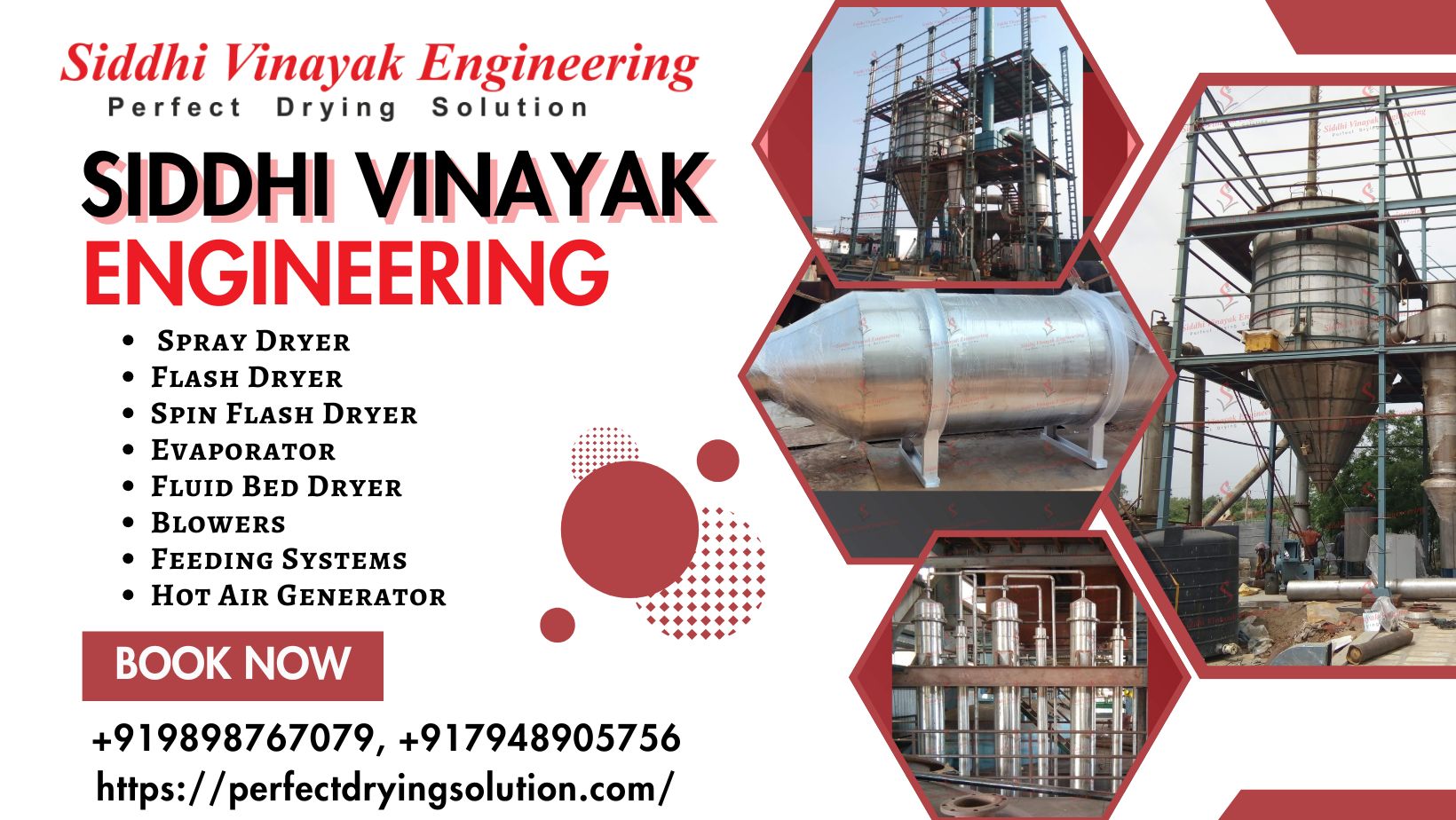
Flash Drying Systems
Flash Drying Systems
Introduction:
A Flash Drying System is a continuous drying equipment used to rapidly remove surface moisture from powders, pastes, and slurries. It works by suspending wet materials in a hot gas stream, where drying occurs almost instantly due to intense heat transfer.
Industries such as chemicals, food processing, pharmaceuticals, minerals, starch, and agro-products rely on flash dryers for fast, efficient drying of heat-sensitive or sticky materials.
How It’s Made:
-
Design & Engineering:
-
CAD-based modeling determines air flow, residence time, and cyclone separation needed for specific materials.
-
-
Fabrication:
-
Built with SS304/SS316 or carbon steel, depending on the application. Key parts include:
-
Air Disperser & Heater
-
Drying Chamber
-
Cyclone Separator / Bag Filter
-
Blower & Ducting System
-
-
-
Assembly & Insulation:
-
The system is assembled with thermal insulation layers, heat-resistant gaskets, and vibration-proof joints.
-
-
Automation & Controls:
-
Fitted with PLC-based control panels, temperature sensors, and humidity monitors to control drying time and energy use.
-
Where It’s Used:
-
Chemical & Pharmaceutical Powders
-
Food Ingredients (starch, spices, dairy powders)
-
Mineral Processing (kaolin, bentonite)
-
Petrochemical and Resin-Based Slurries
-
Detergent & Surfactant Industries
-
Biomass and Wood Pulp
Key Features:
-
High Thermal Efficiency
-
Drying Time: Seconds Only
-
Continuous Feeding and Discharge
-
Low Energy Consumption per Kg
-
Precise Temperature Control (100–400°C)
-
Low Vibration, Low Noise Operation
-
Modular Design for Easy Maintenance
Importance:
Flash dryers enable rapid, uniform drying of materials that are thermally sensitive, sticky, or paste-like, where conventional dryers fail or are too slow. They reduce bacterial load, improve shelf life, and enable high-volume processing with minimal space.
Advantages:
-
Super-Fast Drying — in 1–3 seconds
-
Suitable for heat-sensitive materials
-
Lower operation cost than rotary or drum dryers
-
Compact layout ideal for modern plants
-
Reduces downstream milling or grinding costs
-
Environment-friendly with air filtration options
Significance in Industry:
Flash drying is a game-changer for industries needing speed, hygiene, and precision. It allows real-time drying for integrated processes (like powder mixing or tablet manufacturing), saving energy, increasing yield, and ensuring consistent product quality.
FAQs:
1. What is a flash drying system used for?
Flash dryers are used to quickly dry wet solids, pastes, or slurries with high moisture content into free-flowing powder. They're ideal for thermally sensitive materials, especially in pharma, starch, chemical, and food sectors.
2. How does flash drying work?
The wet feed is atomized or fed into a hot air stream, which instantly evaporates surface moisture. Dried particles are carried by the gas flow to a cyclone separator or bag filter, where product recovery occurs. The process is instant and continuous.
3. What materials can be processed in a flash dryer?
Materials like:
-
Wheat starch
-
Spices
-
Herbal extracts
-
Pigments and dyes
-
Chemical salts
-
Pesticides
can be efficiently processed using flash drying.
4. How is a flash dryer different from other dryers?
Unlike drum or rotary dryers, flash dryers:
-
Require no tumbling or rotation
-
Use less space
-
Are ideal for powder or slurry-like feeds
5. What is the typical drying temperature in flash dryers?
Depending on material and moisture load, temperatures range from 100°C to 400°C. Special materials like proteins or enzymes use lower temperatures to avoid denaturation.
6. Is it suitable for continuous production?
Yes. Flash dryers are designed for continuous, 24x7 operation, integrated with upstream (mixing/feed) and downstream (packaging/grinding) systems.
7. What utilities are needed for installation?
You’ll require:
-
Blower and heater (diesel, electric, or steam)
-
Feeder pump or screw
-
Foundation and cyclone support system
8. Can it handle sticky or paste materials?
Yes. Flash dryers are designed to process sticky, viscous materials that would otherwise clog in conventional dryers, thanks to high-velocity air dispersion.
9. How is dust controlled in flash dryers?
Dust is separated using:
-
Cyclone separators (for coarse recovery)
-
Bag filters or scrubbers (for fine particles)
Modern systems even use wet scrubbers for compliance with pollution control boards.
10. What is the approximate price of a flash drying system?
Based on capacity, materials, and automation, prices range from ₹8 lakh for basic units to ₹1 crore+ for fully automated SS316 food/pharma-grade systems.
Conclusion:
A Flash Drying System offers the perfect balance between speed, energy efficiency, and product quality. Whether you’re in agro-processing, pharma, or chemical production, it’s the go-to solution for bulk powder drying with precision.

